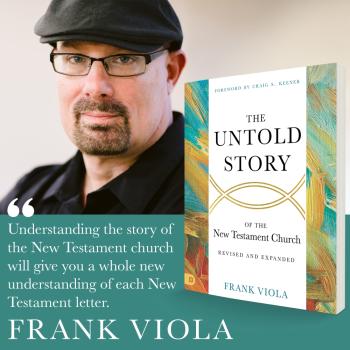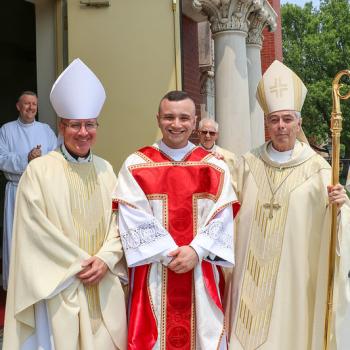Where Peter denied, Nicodemus claims the body of Jesus. Where Judas betrayed, Joseph of Arimathea offers a tomb.
And they touch the lifeless body of Christ. They gather his limp corpse off the cross—his mouth hanging open, his chest still—and take him to be buried. No other disciple can claim such courage, the willingness to feel the cold, bloodied body of a man who promised them all eternal life. They hold tragedy in their arms: his and their own, the disciples' and the world's.
The disciples wait until Jesus lives again before they emerge. Thomas doubts until he puts a finger in the open wounds of a resurrected Jesus. They don't even believe Mary's first report of the resurrection, their faith has been so shattered by the death of Jesus. But the faithfulness of Nicodemus and Joseph blooms on Holy Saturday before resurrection, in the absence of their Lord, in the death of God. It is not that they revel or find joy in the death of Jesus, but they know that there must be someone to ferry the body of a dead Lord to the place of resurrection, someone with the courage to walk in the valley of the shadow of death, with the burden of a lifeless God.
And, as the Gospel of John tells the story, they prepare his body according to the ritual burial customs, with spices and strips of linen cloth. In the death of God, they wash their Lord's wounded feet, perfume his battered body, and clothe him in white. There is no more beautiful image in scripture, to me, of the strength of humanity, of the ability to hope and to remain faithful, when everything else has failed, to love that which has let you down, to tend to that which is dead.
In liturgical churches, the evening of Holy Saturday is punctuated by the first service of Easter, as if we cannot hurry quickly enough to resurrect Jesus. We cultivate a fire in the darkness and we light the Paschal candle. There is hope to be had in this, and the Great Vigil of Easter traditionally has been the service for baptism for new Christians or converts and for the congregation to renew their own baptismal vows.
But this service also mimics the disciples. Like the disciples, we often wait for the resurrection to renew our faith and to affirm Jesus as our lord. We wait for the light to chase away our darkness, for something tangible to assure us that God is not dead. We believe in God when it is easy and bright. But what power, what audacity, what courage is there in such a barter of faith? Instead, perhaps, we should be like Joseph and Nicodemus who affirm their faithfulness on the darkest day in Christian history, who walk into the darkness ready to be the light when the Lord has disappeared, has fallen as silent as the grave, has stopped breathing holy spirit into the world. What courage there is in people who still believe, even when the Lord is dead. What audacity there is in people who still follow, not because Jesus lives in triumph, but because it is simply the Way. What power there is in people who will carry God whenever God dies.
What beauty there is in people who find their faith in the dark.
Because without these people—without Joseph or Nicodemus—there can be no empty tomb, no resurrection, no Easter.
O God, today we stand before the gaping maw of a tomb that is not empty. May we not scatter at the silence of God. May we not shrink from the weight of your limp body. May we not hide from the death of God. Give us courage to walk in the valley of the shadow of death and fear no evil, for you are with us, even if we must carry you, even if you burden us as we bear you to your tomb. Let us prepare the body of God; Let us renew our faith in darkness, not in light; Let us place the stone over the tomb, for this dark path is yet our path to God.
Easter: Opening to the Complexity
On Easter, many churches fill to capacity. Women pin flowers to lapels, men wear suits, and small children don new outfits in bright colors. The whole congregation teems with excitement, joy, and expectation. There are Easter eggs hidden on the church grounds and potluck dishes are warming in parish hall ovens.
Few services in the Christian tradition clash so violently with what really happened in our sacred texts. The resurrection does not begin with triumph, hope, or shouts of joy. Instead, the resurrection begins with fear, disbelief, and troubling silence.
Early Sunday morning, a small group of women arrive at the tomb of Jesus, and find the tomb empty, a man dressed in white bearing a cryptic message that Jesus had been raised. Their response isn't to clap their hands and weep with joy. Nor is their response to cry out, "Alleluia, Christ is risen indeed!"
Rather, they run like hell in fear and don't dare breathe a word of the resurrection, so terrified were they. In the gospel of Mark, the earliest of the four records of Jesus' life, the story ends there, disarming in its abruptness, troubling in its lack of closure. Even when later gospel writers fill out the story with more satisfactory embellishments, the disciples' response is almost always fear and disbelief. For example, in the gospel of Luke, the disciples refuse to believe the women's report of resurrection, calling it nonsense, and Peter so distrusts them that he races to the tomb himself.




